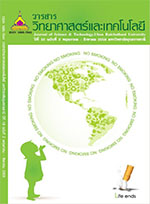ตัวแบบพยากรณ์จำนวนผู้มีงานทำในประเทศไทย
Main Article Content
บทคัดย่อ
วัตถุประสงค์ของการวิจัยครั้งนี้คือ การสร้างตัวแบบพยากรณ์ที่เหมาะสมที่สุดของจำ นวนผู้มีงานทำในประเทศไทย โดยใช้ข้อมูลจากเว็บไซต์ของระบบฐานข้อมูลด้านสังคมและคุณภาพชีวิต ตั้งแต่ไตรมาสที่ 1 ปี 2544 ถึงไตรมาสที่ 4 ปี 2557 จำนวน 56 ค่า ผู้วิจัยได้แบ่งข้อมูลออกเป็น 2 ชุด ชุดที่ 1 คือ ข้อมูลตั้งแต่ไตรมาสที่1 ปี 2544 ถึงไตรมาสที่ 4 ปี 2556 จานวน 52 ค่า สำหรับการสร้างตัวแบบพยากรณ์ด้วยวิธีการทางสถิติ 3 วิธี ได้แก่ วิธีบอกซ์-เจนกินส์ วิธีการ ปรับเรียบด้วยเส้นโค้งเลขชี้กำลังของวินเทอร์แบบบวก และวิธีการพยากรณ์รวม ชุดที่ 2 คือ ข้อมูลตั้งแต่ไตรมาสที่ 1 ถึง ไตรมาสที่ 4 ปี 2557 จำนวน 4 ค่า สำหรับการตรวจสอบความแม่นของตัวแบบพยากรณ์ด้วยเกณฑ์เปอร์เซ็นต์ความคลาดเคลื่อนสัมบูรณ์เฉลี่ย และเกณฑ์รากที่สองของความคลาดเคลื่อนกา ลังสองเฉลี่ยที่ต่ำ ที่สุด ผลการวิจัยพบว่า จากวิธีการพยากรณ์ทั้งหมดที่ได้ศึกษา วิธีการพยากรณ์รวมเป็นวิธีที่มีความเหมาะสมกับอนุกรมเวลาชุดนี้มากที่สุด ซึ่งมีตัวแบบพยากรณ์เป็น
=1,084.566199-0.371898
+1.340197
เมื่อ และ
แทนค่าพยากรณ์เดี่ยว ณ เวลา t จากวิธีบอกซ์-เจนกินส์ และวิธีการปรับเรียบด้วยเส้นโค้งเลขชี้กำลัง ของวินเทอร์แบบบวก ตามลำดับ โดยมีค่าเริ่มต้น คือ ไตรมาสที่ 1 ปี 2557 (t = 1)
Forecasting Model for the Number of Employed Person in Thailand
The purpose of this research was to construct the most suitable forecasting model for the number of employed person in Thailand. Data were gathered from the website of the Social and Quality of Life Database System during the first quarter, 2001 to the fourth quarter, 2014 (56 values) and divided into two categories. The first category had 52 values which were the data from the first quarter, 2001 to the fourth quarter, 2013 for the modelling by the methods of Box-Jenkins, Winters’ additive exponential smoothing, and combined forecasting. The second category had 4 values, which were the data from all four quarters in 2014 for checking the accuracy of the forecasting models via the criteria of the lowest mean absolute percentage error and root mean squared error. The results showed that for all forecasting methods that had been studied, combined forecasting method was the most suitable for this time series and the forecasting model was
=1,084.566199-0.371898
+1.340197
where and
represented the single forecasts at time t from Box-Jenkins and Winters’ additive exponential smoothing respectively, with the starting value of the first quarter, 2014 (t = 1).
Article Details
บทความที่ได้รับการตีพิมพ์เป็นลิขสิทธิ์ของ วารสารวิทยาศาสตร์และเทคโนโลยี มหาวิทยาลัยอุบลราชธานี
ข้อความที่ปรากฏในบทความแต่ละเรื่องในวารสารวิชาการเล่มนี้เป็นความคิดเห็นส่วนตัวของผู้เขียนแต่ละท่านไม่เกี่ยวข้องกับมหาวิทยาลัยอุบลราชธานี และคณาจารย์ท่านอื่นๆในมหาวิทยาลัยฯ แต่อย่างใด ความรับผิดชอบองค์ประกอบทั้งหมดของบทความแต่ละเรื่องเป็นของผู้เขียนแต่ละท่าน หากมีความผิดพลาดใดๆ ผู้เขียนแต่ละท่านจะรับผิดชอบบทความของตนเองแต่ผู้เดียว


